|
|
|
Sort Order |
|
|
|
Items / Page
|
|
|
|
|
|
|
| Srl | Item |
| 1 |
ID:
076930


|
|
|
|
|
| Publication |
2007.
|
| Summary/Abstract |
This article addresses the increasing militarisation of the Italian borders and the establishment of detention centres reminiscent of concentration camps as a state response to potential immigrants, asylum seekers and others. We suggest that this militarisation should be understood as part of the remaking of the Italian state in relation to recent Italian political and economic history and the current hegemonic social and political ethos in Europe more generally. Since early 1990s, European, and specifically Italian ideology has embraced a neoliberal ethos of individualism and cultural particularity that encourages the politicisation of exclusionary regional and national geographies and the intensified policing of the borders. In the current political and economic context, non-Europeans from poor countries seeking entry into Italy are categorised as outsiders and therefore non-human. The ethos made popular by Italian political parties since the l990s degrades moral claims, extracts citizens from their embeddedness in social relations, and wipes out any possible space for the purely human being.
|
|
|
|
|
|
|
|
|
|
|
|
|
|
|
|
| 2 |
ID:
187367
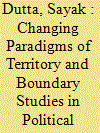

|
|
|
|
|
| Summary/Abstract |
Boundary studies as a sub-discipline of political geography has undergone several momentous transformations during its evolution. The classical period was predominantly concerned with demarcating the ideal boundary for achieving a stable geopolitical order. This changed during the latter part of the 20th century when scholars began contemplating the role of boundary as a social force. Postmodern understanding of boundaries concerned itself with questions of identity and the narratives of boundary. The focus on territory and territoriality marks another departure from contractual boundary between states to a more cultural notion. In stark contrast to the spatial perception of boundary and territory stands the stream of literature exploring social boundaries investigating the symbolic boundaries that facilitate the social differentiation between various groups of people. The present study comprehensively reviews the three intertwined branches and indicates the need to fuse these traditions and offer suggestions on how to do so. The article also contemplates necessary adaptations to the field going forward.
|
|
|
|
|
|
|
|
|
|
|
|
|
|
|
|
| 3 |
ID:
148792
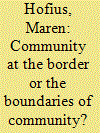

|
|
|
|
|
| Summary/Abstract |
This article contributes to the communities of practice (CoP) literature by focusing on the neglected role of the boundary in constructing community. It takes issue with advocates of International Relations’ (IR) most recent ‘practice turn’ who have overrated inclusive practices of linking to the detriment of taking account of exclusive practices of demarcation. A conceptual turn to the boundary, understood as a ‘site of difference’, highlights how the two sets of practices operate simultaneously in creating shared senses of belonging to a community. The article empirically probes this turn to the boundary by studying how the postmodern community of the European Union (EU) is (re)constructed by EU diplomats in its neighbouring state Ukraine. As a borderland, it symbolises an interstitial zone of high connectivity where the EU’s otherwise latent order is unearthed. A reconstructive analysis of interviews with members of this ‘community of practice’ reveals that they function as ‘boundary workers’ who engage in both boundary-spanning and boundary-drawing practices on an everyday basis. Zooming in on the ‘boundary work’ by EU diplomats exposes the complex process of community-building and thereby helps grasp community as an emergent structure of possibilities whose meaning is contextually mediated by its members’ social experience of the boundary.
|
|
|
|
|
|
|
|
|
|
|
|
|
|
|
|
| 4 |
ID:
175072
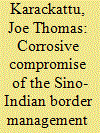

|
|
|
|
|
| Summary/Abstract |
India and China have entered a new low in their bilateral relations. Having fought a war in 1962, it took over three decades for both countries to achieve normalcy at the borders, aided by a series of border management agreements and protocols to maintain tranquility along the border areas. However, the June 2020 Galwan clashes have changed that permanently. This paper argues that the current escalation of border clashes is both a symptom and consequence of the breakdown of the bilateral border management framework which has been dented since the 2017 Doklam standoff between both countries. Delving into diplomatic history relating to Doklam and Galwan, the findings point to the need to correct the epistemic criteria used to reproduce claims of an unambiguous boundary between India and China by both countries, in order to ensure abatement of similar outcomes.
|
|
|
|
|
|
|
|
|
|
|
|
|
|
|
|
| 5 |
ID:
108971


|
|
|
|
|
| Publication |
2011.
|
| Summary/Abstract |
On 31 December 1985, Singapore left the United Nations Educational, Scientific and Cultural Organization (UNESCO), turning against the 'New International Information Order' demanded by UNESCO at that time. In October 2007, after 22 years of absence, Singapore rejoined UNESCO, looking for an intensification of cultural and scientific exchange. Taking this example of reviving co-operation between Singapore and UNESCO, this paper assesses the concept of 'creative industries' as a boundary concept that allows for increased co-operation between players with generally opposing knowledge concepts - as manifested in their respective knowledge and cultural politics. The paper starts with a conceptual discussion on the crossing of boundaries. This is followed by an assessment of first, UNESCO's and second, Singapore's gradual repositioning towards culture. While UNESCO turned from distinctly separating 'culture' and 'market' in the 1970s and 1980s to an increased openness for profit-oriented conceptualisations of culture today, Singapore identified the economic potential of culture, creativity and the arts, and therefore the need to foster these as part of its development into a knowledge-based economy. The underlying differences in interests and the orientation of content, expressed by the traditionally opposing conceptualisations of knowledge and culture, are still valid today, yet the concept of 'creative industries', adopted by both sides, seems to offer a common meeting ground. It acts clearly as a bridge, and hence a boundary concept, allowing for an intensification of mutual co-operation. This is discussed in the final part of the paper.
|
|
|
|
|
|
|
|
|
|
|
|
|
|
|
|
| 6 |
ID:
034532


|
|
|
|
|
| Publication |
London, Methuen and co. ltd., 1968.
|
| Description |
387p.Hbk
|
|
|
|
|
|
|
|
|
|
|
|
Copies: C:1/I:0,R:0,Q:0
Circulation
| Accession# | Call# | Current Location | Status | Policy | Location |
| 001055 | 910.132/FIS 001055 | Main | On Shelf | General | |
|
|
|
|
| 7 |
ID:
087131


|
|
|
|
|
| Publication |
2009.
|
| Summary/Abstract |
China's periphery is in the priority of China's foreign policy. Over more than half a century since the founding of the PRC, the major conflicts the nation had to get involved in took place in its periphery. One of the important conclutions thus drawn was that the major threat to China's national security stemmed from its periphery, or from the hostile states that imposed threat to china via its periphery.
|
|
|
|
|
|
|
|
|
|
|
|
|
|
|
|
| 8 |
ID:
138130
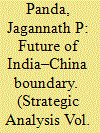

|
|
|
|
|
| Summary/Abstract |
Will India and China resolve their boundary dispute during the tenure of Narendra Modi and Xi Jinping? The strategic communities in both countries are optimistic, particularly after the high tension prevailing along the border during President Xi Jinping’s tour of India in September 2014. Both Prime Minister Modi and President Xi are seen as decisive leaders.1 Both are expected to hold power in their respective countries for a few years to come. Personalities and personas matter greatly for scoring political brownie points. The boundary dispute, quintessentially, is political in nature. The 2005 Agreement on the ‘Political Parameters and Guiding Principles for the Settlement of the India–China Boundary Question’ acknowledged as much: the ‘two sides are seeking a political settlement of the boundary question’.2 In future India–China boundary negotiations, will the two leaders go for territorial exchange or will they remain content with the status quo, and simply define the Line of Actual Control (LAC)?
|
|
|
|
|
|
|
|
|
|
|
|
|
|
|
|
| 9 |
ID:
067317
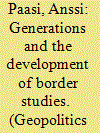

|
|
|
| 10 |
ID:
179345
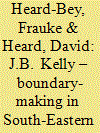

|
|
|
|
|
| Summary/Abstract |
This is a review article of J. B. Kelly's three-volume work Desert Dispute: The Diplomacy of Boundary-Making in South-Eastern Arabia, ed. Saul B. Kelly (Gerlach Press, Berlin, 2018 and 2020). It covers in detail the diplomatic background to the development of the frontiers of Saudi Arabia, the UAE, Qatar and Oman, from 1911 to the 1990s, including the involvement of tribal shaikhs, Ibn Saud, the Ottomans, the British and American governments, and also the oil companies prospecting in the region.
|
|
|
|
|
|
|
|
|
|
|
|
|
|
|
|
| 11 |
ID:
097379
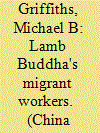

|
|
|
| 12 |
ID:
105292


|
|
|
| 13 |
ID:
187410
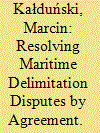

|
|
|
|
|
| Summary/Abstract |
The extension of coastal states’ jurisdiction over seas in the twentieth century significantly increased the maritime area of overlapping entitlements. The Baltic Sea is a textbook example of such competing claims. In principle, the two main avenues for a coastal state to resolve its dispute are to either conclude a delimitation agreement or lodge the case with an international court or tribunal. This article analyzes the Delimitation Agreement between Denmark and Poland concerning the Baltic Sea south of the island of Bornholm. The states were divided as to how to apportion the maritime zone of 3,500 km2, where the economic zones of Denmark and Poland had not been delimited for several dozen years. The agreed single maritime boundary split the disputed area into unequal parts. The settlement of the maritime dispute coincided temporally with Poland and Denmark’s plans to build a natural gas pipeline at the bottom of the Baltic Sea, which probably prompted the two states to put an end to their maritime boundary dispute. The law of the sea provides that the delimitation of maritime zones between states with opposite or adjacent coasts is effected by agreement on the basis of international law in order to achieve an equitable solution. The purpose of this article is to show that (energy) security issues may prompt a resolution of a maritime boundary dispute, and to analyze the Polish–Danish Agreement in the light of the principles governing the maritime delimitation.
|
|
|
|
|
|
|
|
|
|
|
|
|
|
|
|
| 14 |
ID:
182599


|
|
|
|
|
| Summary/Abstract |
The controversy surrounding the Simla Conference of 1913–1914 and the legality of the McMahon line, which was produced by the Conference, has been at the centre of the boundary dispute between India and China. Amidst the diverging opinions amongst scholars and political commentators, the main issue rest on the unresolved question of Tibet’s political status. Was Lhasa authorised to sign treaties for Tibet? Was China the sovereign over Tibet? The answers to such questions are murky and complicated, made more so by the politics and conflicts in the post colonial period. This study attempts to highlight the complicated nature of political authority in Tibet through a study of British policy in Tibet towards the end of 19th and early 20th centuries. The signing of the 1890 Convention with China and the 1904 Convention with Tibet represents two extremes in British foreign policy which attest to the confounding situation presented before the British and the diverging opinions within the British official circles. The period between these two conventions provides a glimpse of the historical background in which the relations between British India, China and Tibet developed subsequently.
|
|
|
|
|
|
|
|
|
|
|
|
|
|
|
|
| 15 |
ID:
062624


|
|
|
|
|
| Publication |
Apr-Jun 2005.
|
|
|
|
|
|
|
|
|
|
|
|
|
|
|
|
| 16 |
ID:
135184
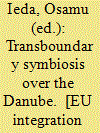

|
|
|
|
|
| Publication |
Sapporo, Uyana Tomohiko, 2014.
|
| Description |
133p.Pbk
|
| Series |
Slavic Eurasian studies; no.27
|
| Standard Number |
9784938637804
|
|
|
|
|
|
|
|
|
|
|
|
Copies: C:1/I:0,R:0,Q:0
Circulation
| Accession# | Call# | Current Location | Status | Policy | Location |
| 058014 | 320.12437309439/IED 058014 | Main | On Shelf | General | |
|
|
|
|
| 17 |
ID:
101297


|
|
|
|
|
| Publication |
2010.
|
| Summary/Abstract |
Within the context of Kyrgyzstan's capital Bishkek, this article deals with an identity boundary between the so-called 'urban' Kyrgyz and Russians on the one side, and the so-called 'rural' or 'newly arriving' Kyrgyz, on the other. In the first section I discuss the ways in which this boundary is constructed among Bishkek male youth, both rhetorically as well as with regard to actual practices of social inclusion and exclusion. Starting from these insights on what 'makes' an urban identity, I try to approach the question of why this boundary might be drawn as it is. Linking a theory on 'group size' with migration data for Kyrgyzstan and the concept of 'opportunity structure', I try to examine the allocation and accessibility of opportunities such as jobs, marriage and living space - all of which can be considered to affect the current divide between ethnic Kyrgyz in Bishkek.
|
|
|
|
|
|
|
|
|
|
|
|
|
|
|
|
| 18 |
ID:
153293


|
|
|
|
|
| Summary/Abstract |
Members of the British Labour party have, not for the first time, criticised the Boundary Commissions’ proposals for new constituency boundaries as gerrymandering. This represents a misuse of the term: the Commissions have produced recommended constituencies in the context of new rules for such redistributions that give precedence to equality of electorates across all seats and the boundaries of those constituencies have been defined without any reference to the likely electoral consequences. The Conservatives, who were responsible for the change in the rules to emphasise electoral equality, wanted to remove a decades-long Labour advantage in the translation of votes into seats because of variations in constituency size, and the Commissions’ implementation of those rules has achieved that. A Labour advantage has been removed but not replaced by a Conservative advantage: in terms of electoral equality between the two, the playing field has been levelled. Labour's claim to have been disadvantaged by decisions on the electoral register is also examined; the disadvantage is probably only small.
|
|
|
|
|
|
|
|
|
|
|
|
|
|
|
|
|
|
|
|
|